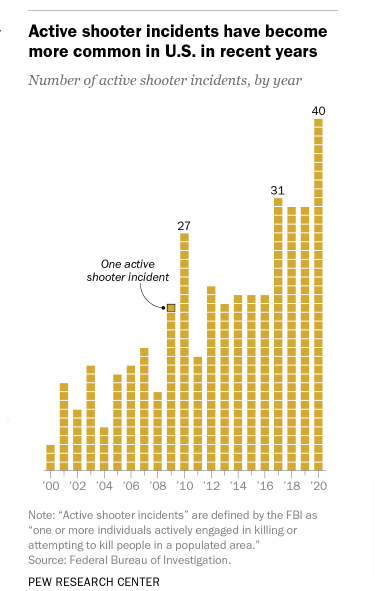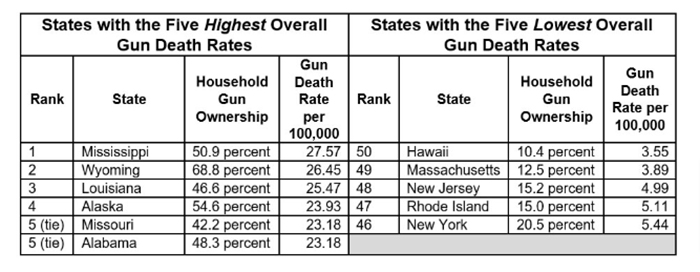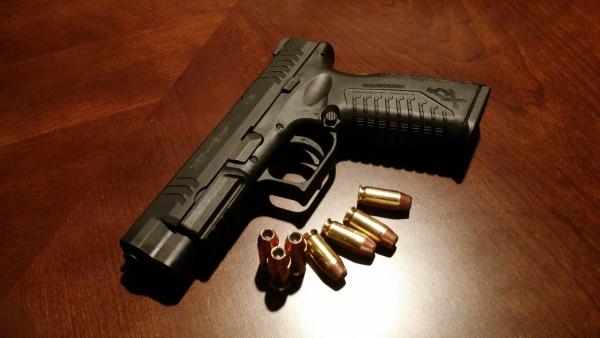In 2020, there were 45,222 deaths as a result of firearms.
- 53.7% were suicides – self-inflicted death by firearms is the most effective of any method, with a case fatality rate of 82.5%.
- 42.8% of deaths by firearms were due to homicide
- The remaining 3.5% of deaths were accidental, police related, or undetermined
- 59% of US gun murders and non-negligent manslaughters were attributable to handguns. 1% involved shotguns, and 3% involved rifles that included assault weapons.
 There is no agreed-upon definition of a mass shooting event. You can see how the definition alters the number of associated deaths when the Pew Research reports:
There is no agreed-upon definition of a mass shooting event. You can see how the definition alters the number of associated deaths when the Pew Research reports:
- “The FBI collects data on “active shooter incidents,” which it defines as “one or more individuals actively engaged in killing or attempting to kill people in a populated area.” Using the FBI’s definition, 38 people – excluding the shooters – died in such incidents in 2020.
- The Gun Violence Archive, an online database of gun violence incidents in the U.S., defines mass shootings as incidents in which four or more people are shot, even if no one was killed (again excluding the shooters). Using this definition, 513 people “died in these incidents in 2020.”
- Mass shootings are increasing in frequency, irrespective of your definition.
The Gun Control Act of 1968 required federally licensed firearms dealers to obey federal and state restrictions. These dealers “cannot sell firearms to certain prohibited persons (e.g., felons, fugitives, drug users), must have the purchaser of a firearm complete disclosures on a federal form, and must perform a background check on the person who is purchasing the weapon.”
Since state firearm laws are layered on top of federal regulation, gun deaths reflect differences in rural and urban environments, the degree of despair (as suicide is the most common form of gun death), and the availability of guns.

Gun availability reflects cultural attitudes towards guns and adherence to existing gun laws. We have a long history of prohibitions on desired products, alcohol, weed, tobacco, and firearms. In every instance, it results in the rise of unregulated marketing – in this instance, the trafficking of guns.
Trafficking Guns
Firearms dealers in New York must also abide by New York’s regulations, which according to NY’s Attorney General, are “some of the strongest gun safety laws in the country.” Including:
- Prohibition of the sale of high-capacity magazines
- A system to prevent people “with dangerous mental infirmities” from obtaining a gun
- Universal background checks at gun shows and private sales
- A comprehensive process of fingerprinting, photos, background checks, and character references before being issued a license to purchase a handgun. A license that is maintained in a central database and requires periodic renewal.
- A firearms trace for every firearm recovered by law enforcement – “crime” guns.
Tracing these crime guns is also part of the 1968 Gun Control Act. It prohibits the creation of a comprehensive central database and therefore requires a lengthy, manual search to follow a gun from manufacturer to its “last known retail sale.” These traces “do not capture any unrecorded, private sales associated with a firearm,” and many records are missing.
According to one study by the Bureau of Alcohol, Tobacco, Firearms, and Explosive (ATF) in 2000 looked at trafficked, illegal gun purchases.
- 41.3% were straw purchases from federally licensed dealers. A straw purchase is where “those who buy a gun, complete required paperwork, and undergo a background check on behalf of another, prohibited, person. They are illegal transactions concerning firearms.
- 27.3% were unlicensed sellers
- 17.7% were Illegally diverted by licensed dealers (6.3%), gun show sales (7.1%), and secondary markets (4.3%)
- 22.5% were stolen from dealers, residencies, and common carriers
- The percentages do not reflect the number of guns trafficked [explain]. In terms of the number of firearms trafficked, the majority, 70%, consisted of
- straw purchases 21%
- illegal diversion by licensed dealers (including pawn brokers) 31%
- gun show sales 17%.
A 2016 report of prisoners in both state and federal penitentiaries by the US Department of Justice on firearms used in the commission of a crime concluded:
- 6% were stolen
- 7% were found at the scene of the crime
- 43% obtained them off the street
- 25% got them from a family member or friend
- 7% had been purchased under “their own name from a licensed firearms dealer.”
A study by New York’s Attorney General of the 52,915 guns recovered by New York from the commission of a crime between 2010 and 2015 and traced by the ATF found:
- 74% of the guns originated out of state, half from six neighboring states. “New York City, with its rigorous permitting requirements for all guns, has the highest percentage of out-of-state guns (87%).”
- 75% were handguns “the weapon of choice among violent criminals.” This is more than double the national average of 29%
- 6% of purchasers were the possessor of the gun used in the commission of a crime.
The “Iron Pipeline”
- 70% of “likely trafficked guns” in New York originated in “Iron Pipeline,” States running along the I-95 corridor.
- 95% were handguns – the most commonly used weapon in the commission of crimes
- “Virginia (15%), Georgia (13%), and Pennsylvania (13%) were the top three source states.”
- All of these states were “net exporters” of crime guns, lacking prevention of illegal diversion. “All but one of these states have no requirements for background checks for private sales or at gun shows (Pennsylvania, and only for handguns). And all but one do not require a permit prior to a handgun purchase (North Carolina). This is a stark contrast to the other states along I-95 south, which were responsible for just over 2% of New York’s trafficked guns combined.”
“A well regulated Militia, being necessary to the security of a free State, the right of the people to keep and bear Arms, shall not be infringed.” – Second Amendment to the US Constitution.
In my personal opinion, we have for too long emphasized our right “to keep and bear arms.” It is time we emphasize the first clause, the clause mentioning our responsibilities, to be “well-regulated.”
[1] A thaw in the freeze on federal funding for gun violence and injury prevention research
Note: This article originally carried a different title, which evidently is trademark protected. I was not aware of this and when it was brought to my attention, have altered the title. My apologies for not knowing that a phrase this generic might be legally protected "speech."




